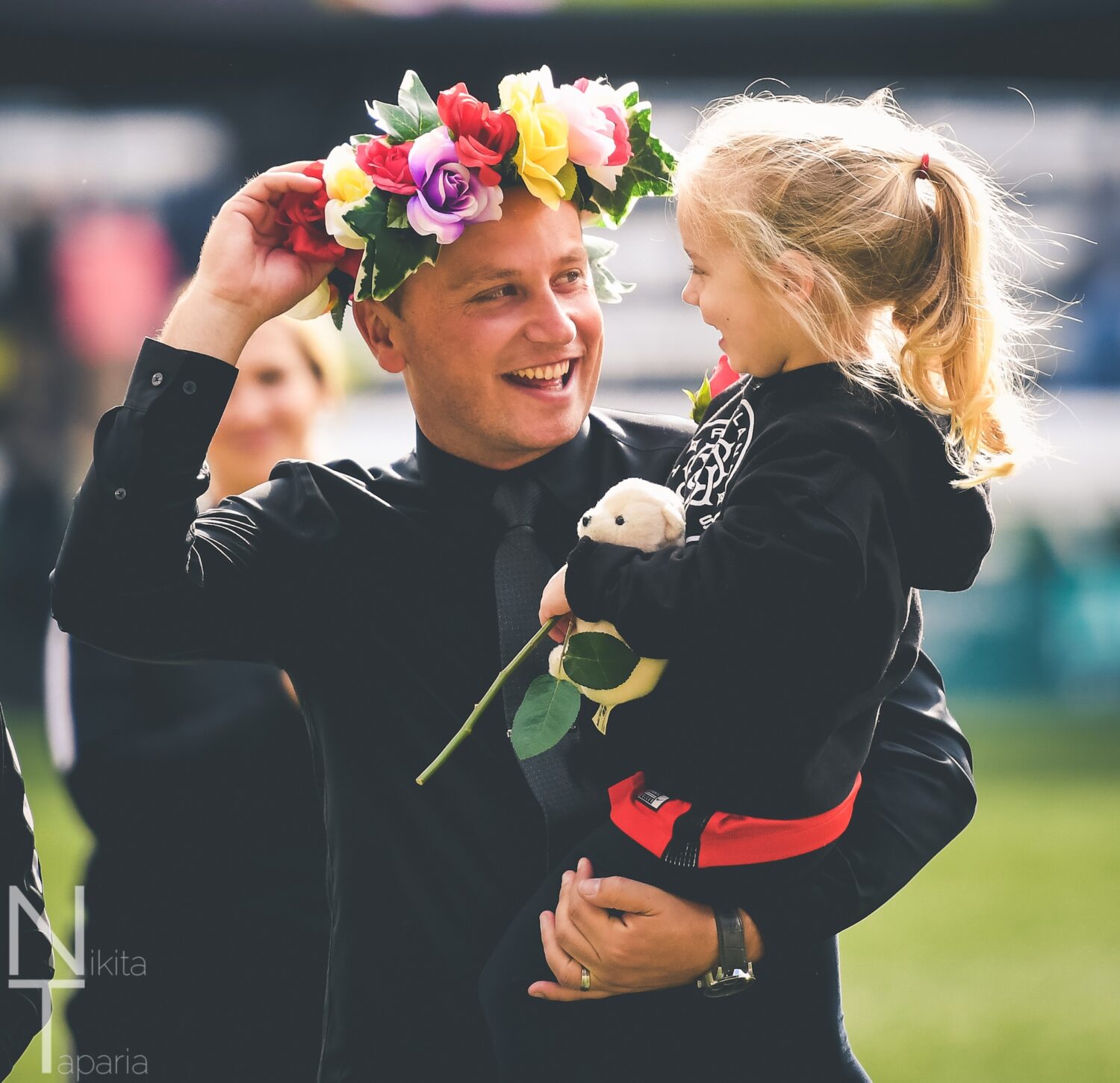To view this content, you must be a member of the Rose City Review Patreon
Already a qualifying Patreon member? Refresh to access this content.
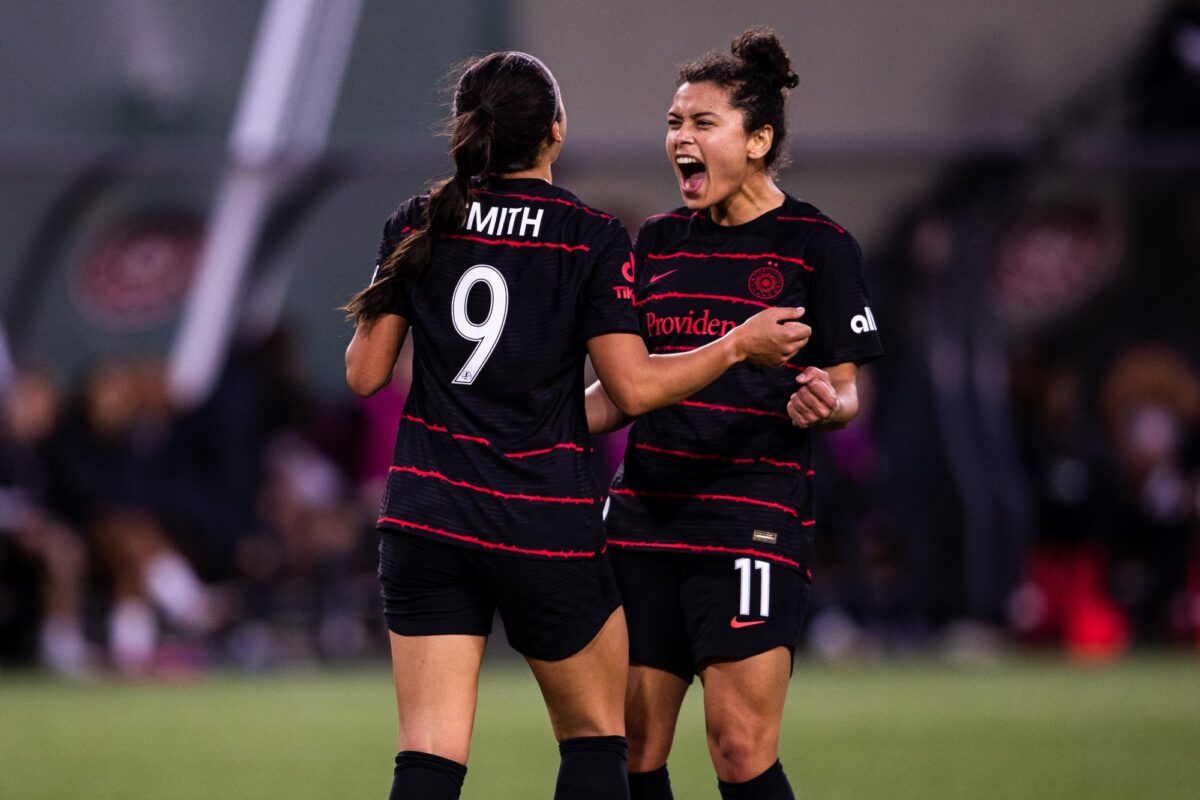
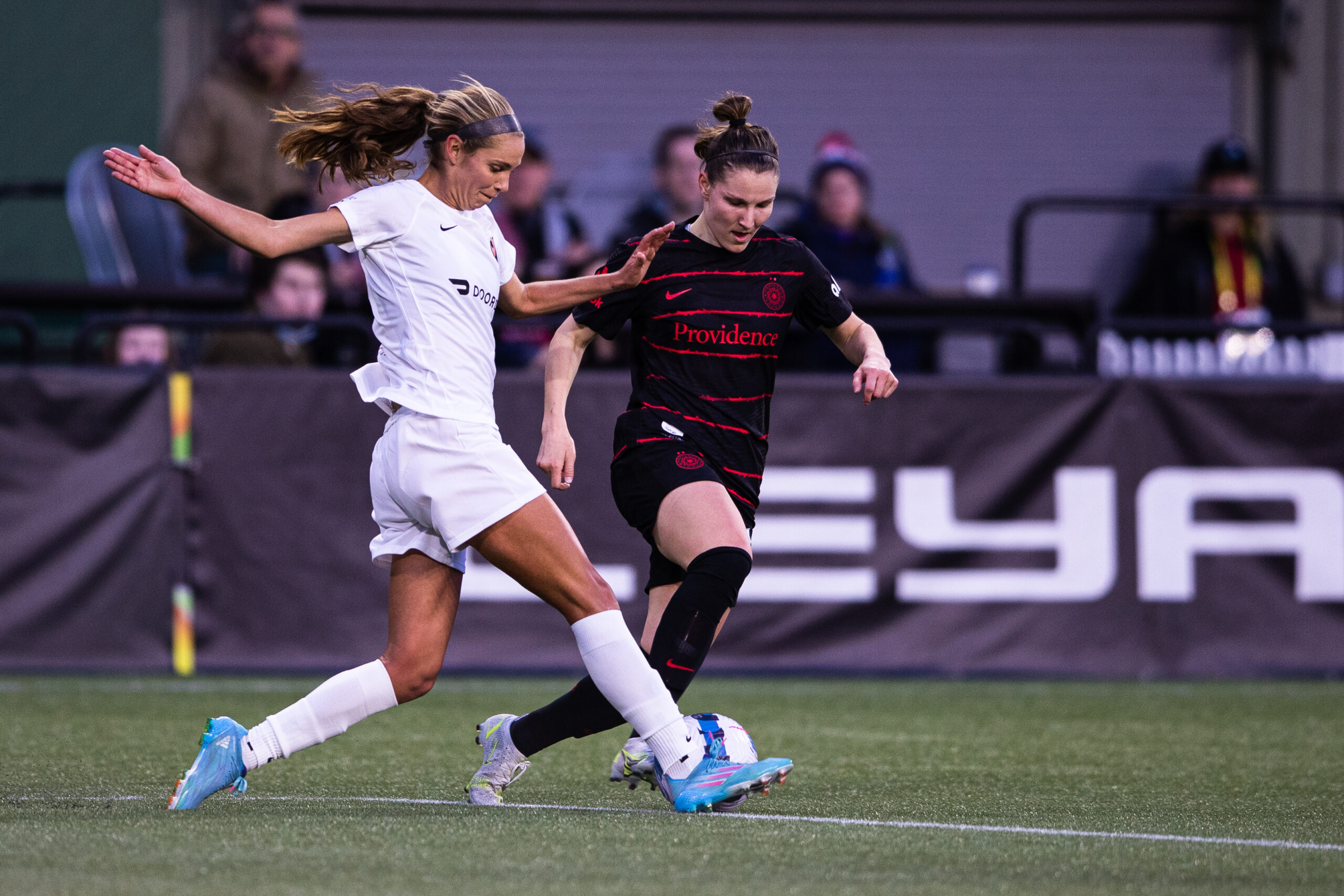
Sunday’s game against Angel City was world’s apart from the Thorns’ first game against them. After beating Los Angeles last time around, the Thorns bowed out of the Challenge Cup in the group stage with a 1-0 loss.
It’s impossible to analyze this game without talking about the five players and head coach Rhian Wilkinson’s absences due to COVID-19 protocols. Sophia Smith, Meaghan Nally, Hina Sugita, and Sam Coffey had all solidified their spots on the Thorns’ starting eleven. A preseason tournament is the ideal time to test out and formulate a consistent starting roster, especially after the turnover the Thorns experienced in the offseason. In the postgame presser, Meghan Klingenberg said that “COVID has been disrupting the world for two years, and now it’s closer to home than it has been. It’s been great to see players on the field who don’t normally start.”
As COVID-19 policies begin to relax nationwide—despite us still being in the midst of a deadly viral pandemic—NWSL teams are going to be caught in the crossfire. This is especially prevalent in the lifting of the federal mask mandate on transportation, as NWSL players do not fly chartered planes. With the country deciding that COVID-19 has ended, long lists of COVID-protocol related absences for teams could become more commonplace, no matter how tight the teams bubble is or how diligent they are in their masking.
Despite the absences, the Thorns were able to put out a great starting eleven, showcasing the depth and quality of their team. Young Olivia Moultrie got her first start of the calendar year, and Janine Beckie played a full 90 minutes on her debut game for the Thorns. Acting coach Mike Norris said after the defeat that the “challenging week” was “no excuse for the team’s poor performance.”
Last year, the theme of the Thorns was about building a strong culture. With a new head coach, it’s inevitable that the culture will shift, and a new one needs to be created. In the final game of the Challenge Cup, the Thorns were forced to test the strength of that new mentality.
During the tournament, the Thorns debuted two primary formations, a 3-5-2 and a 4-3-3. With the change of formation and change of head coach comes a change of principles. Unfortunately, it seems as though the Thorns have lost their way in recent games. The second half of the game against San Diego and all 90 minutes of play against Angel City felt uninspired and lacked urgency. The Thorns were unable to score in those 135 minutes and allowed three goals.
With eight shots total against Lost Angeles, three of which were on target, the Thorns didn’t look nearly as threatening as they normally do.
At no point after Angel City scored their penalty kick did I believe that the Thorns were going to score an equalizer. The midfield was nonexistent, and the forwards were not making the necessary runs in the box when the ball was crossed. The game was a must-win if the team wanted to move onto the semi-finals of the Challenge Cup and defend their title, yet it felt as though there were no stakes. Going down in the first half of a must-win game needed to turn on a fire for the Thorns, but it didn’t. Like Kling said postgame, “the team got away from their principles.”
While the league itself is making the Challenge Cup seem more like a joke with each announcement (Reign having to host their semi-final game at Segra Field, anyone?), the Thorns needed to use the tournament to try and gain chemistry, especially between pairings. Unfortunately, they ended the tournament poorly.
Still, it’s important to remember the extenuating circumstances. The stress of playing sports in the middle of a (still ongoing) global pandemic is hard enough when there aren’t national or league-wide safety procedures in place to help protect players and staff. Emotions are high, and it’s important to remember that the athletes on the field are people. The Thorns didn’t play with intensity or drive like they normally do, but they are still the Portland Thorns, and there is always another game for them to play.
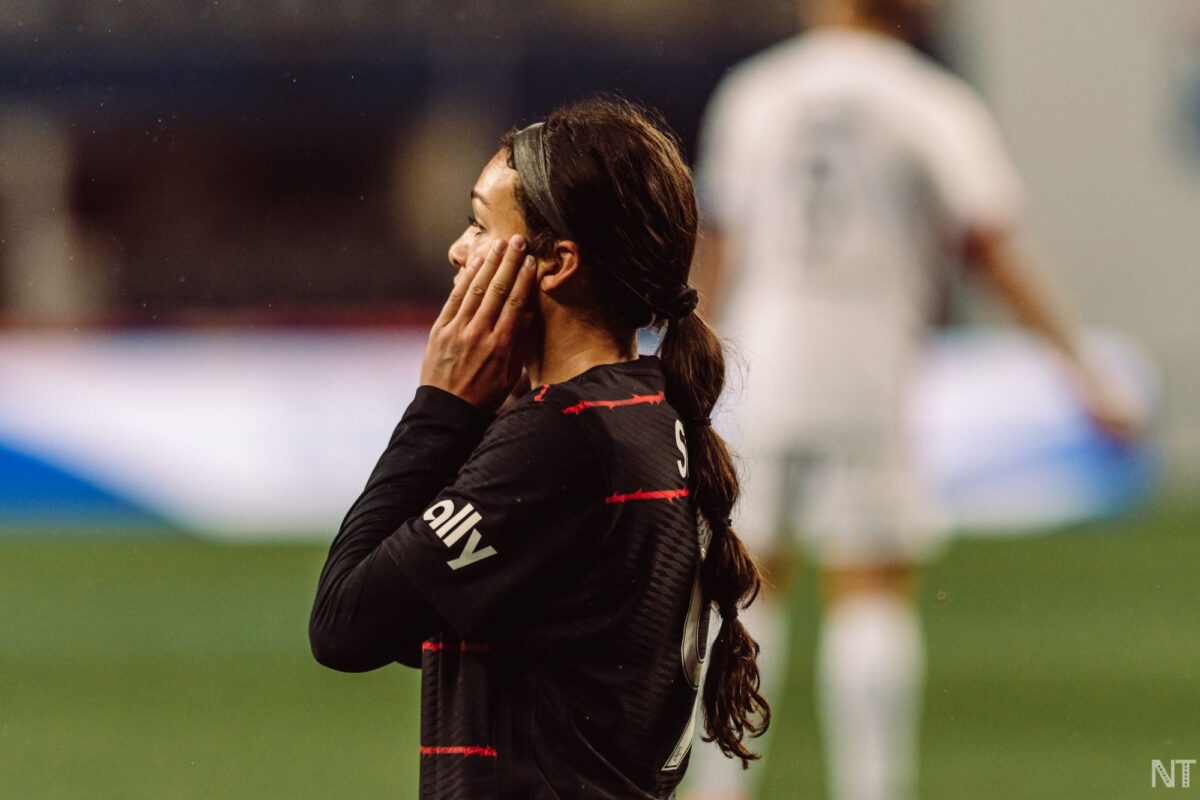
The Thorns earned a 3-2 win against the San Diego Wave on Sunday, knocking the Wave out of the running for the Challenge Cup semifinals with a strong first half. Still, Portland’s second half left room for improvement.
For the first time this year, the Thorns played a 4-3-3 formation, with Meghan Klingenberg, Kelli Hubly, Emily Menges, and Meaghan Nally spread across the defense and Sophia Smith, Christine Sinclair, and Morgan Weaver sitting as the front three.
Head coach Rhian Wilkinson said after the game that the Thorns are using the Challenge Cup to gradually add in different tactics that she wants the team to use throughout the regular season. “To have two weeks without a game when the internationals went, I felt like it was the right time to to deliver a new structure,” Wilkinson said.
The formation meant the Thorns didn’t have as many numbers wide, and, unsurprisingly, they played more through the middle as a result. We can see that through the average player positions between the Thorns’ last game against OL Reign—where they played a 5-3-2—and Sunday’s game against the Wave, where players are more clustered in the center of the park:


“What I’ve loved is I think you can see this team buys in,” Wilkinson said of the new formation. “They trust one another.”
That trust was evident in the first half. The Thorns dominated those 45 minutes, winning balls, controlling the midfield, and getting chance after chance off. They ended the half with 16 shots to San Diego’s four and a 3-0 lead to show for it.
Smith opened the scoring in the fourth minute when she got on the end of an on-the-ground cross from Weaver, touched the ball just around her defender, and sent a shot into the far corner that San Diego’s Carly Telford wasn’t able to react to in time.
Portland struck again in the 21st and 41st minutes, as Hina Sugita tallied her first two goals for the team. In both cases, she exposed San Diego’s defensive marking, getting on the ends of rebounds to hit the ball into the back of the net. And it doesn’t hurt that they were both fun to watch:
Hina Sugita scores her first NWSL goal to put us up by 2. Congrats Hina!!! #BAONPDX pic.twitter.com/T1ZPZxTp43
— Portland Thorns FC (@ThornsFC) April 17, 2022
Thoughts anyone? 🧐🤔 #BAONPDX pic.twitter.com/DzvUlisCqx
— Portland Thorns FC (@ThornsFC) April 18, 2022
“If you’ve watched her the last few games, this is what she’s been doing,” Wilkinson said of Sugita. “I think she’s just gaining in confidence every game and did very well today.”
But if the first half was a breeze for the Thorns, the second half was anything but. San Diego brought in rookie Kelsey Turnbow after the break, and she immediately went to work terrorizing Portland’s defense. In just the first minute, she played a perfect ball into Alex Morgan, whose shot left Bella Bixby scrambling to her feet as Bella Briede picked up the ball at the top of the six and buried her shot.
The game’s momentum shifted in favor of the Wave after that, with San Diego growing into the midfield and forcing the Thorns into a lot of last-ditch defending. San Diego got of 13 shots in those final 45 minutes, while Portland managed only two. “Our talk halftime was keep the standard up,” Sam Coffey said after the match, “and we didn’t do that.”
Taylor Kornieck further cut into the Thorns’s lead coming off the bench in the 67th minute, scoring a header off a Wave corner kick by virtue of her positioning and being tall.
Although the Thorns were able to hold onto the win, it was a gritty end to a dominant start. “Something Rhian really emphasizes for our group is winning the right way,” Coffey said. “I don’t think we we did that to the best of our ability.
“That doesn’t mean that we hang our heads low or we’re all disappointed, but it’s fuel for the fire,” she said. “I think that’s a good thing for this group, especially with another game just around the corner.”
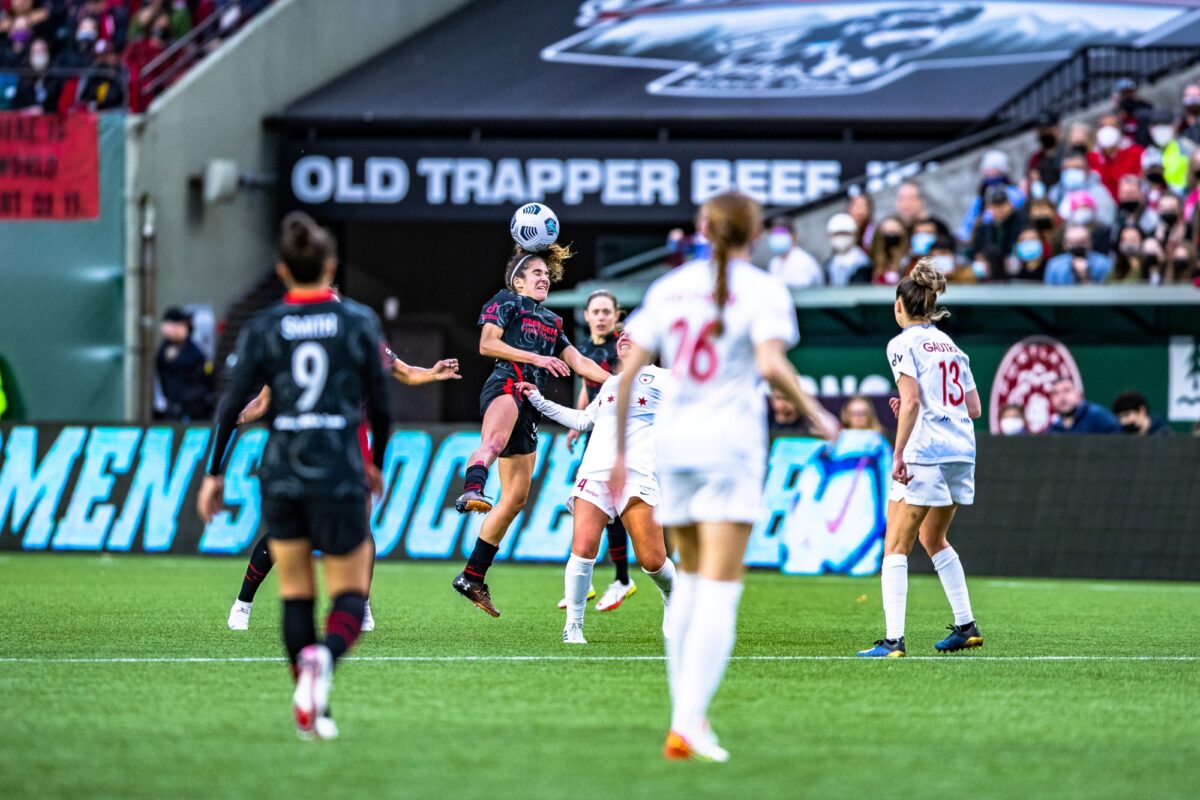
Wednesday night’s inaugural game against Angel City FC saw several Thorns professional debuts in a decisive 3-0 victory. The Thorns dominated on every stat except possession and played a high-press game, particularly in the second half. Portland ended the night with 14 shots—seven of which were on target—and 13 crosses, all of which were double what Los Angeles was able to produce. Despite being early into preseason with several key players out on injury or limited minutes, the Thorns are looking strong and cohesive, and the numbers reflect that.
I’ve attended all of the Thorns games thus far, this was by far the most fun. Nearly 10,000 people attended a mid-week game, which brought a lively atmosphere into the Park. The purple smoke for domestic violence was sent off and the “YOU KNEW” banner flew, reminding everyone about the horrific actions of the front office. On the field, however, the team seemed as though they were having fun and enjoying themselves and the freedom they are given on the field, which is amplified by the crowd.
Three different players scored on Wednesday—including Yazmeen Ryan, who tallied her first professional goal. And, because I think scoring goals is really fun, I am going to attempt to break down what went well to allow the Thorns their first multiple-goal game of the 2022 Challenge Cup.
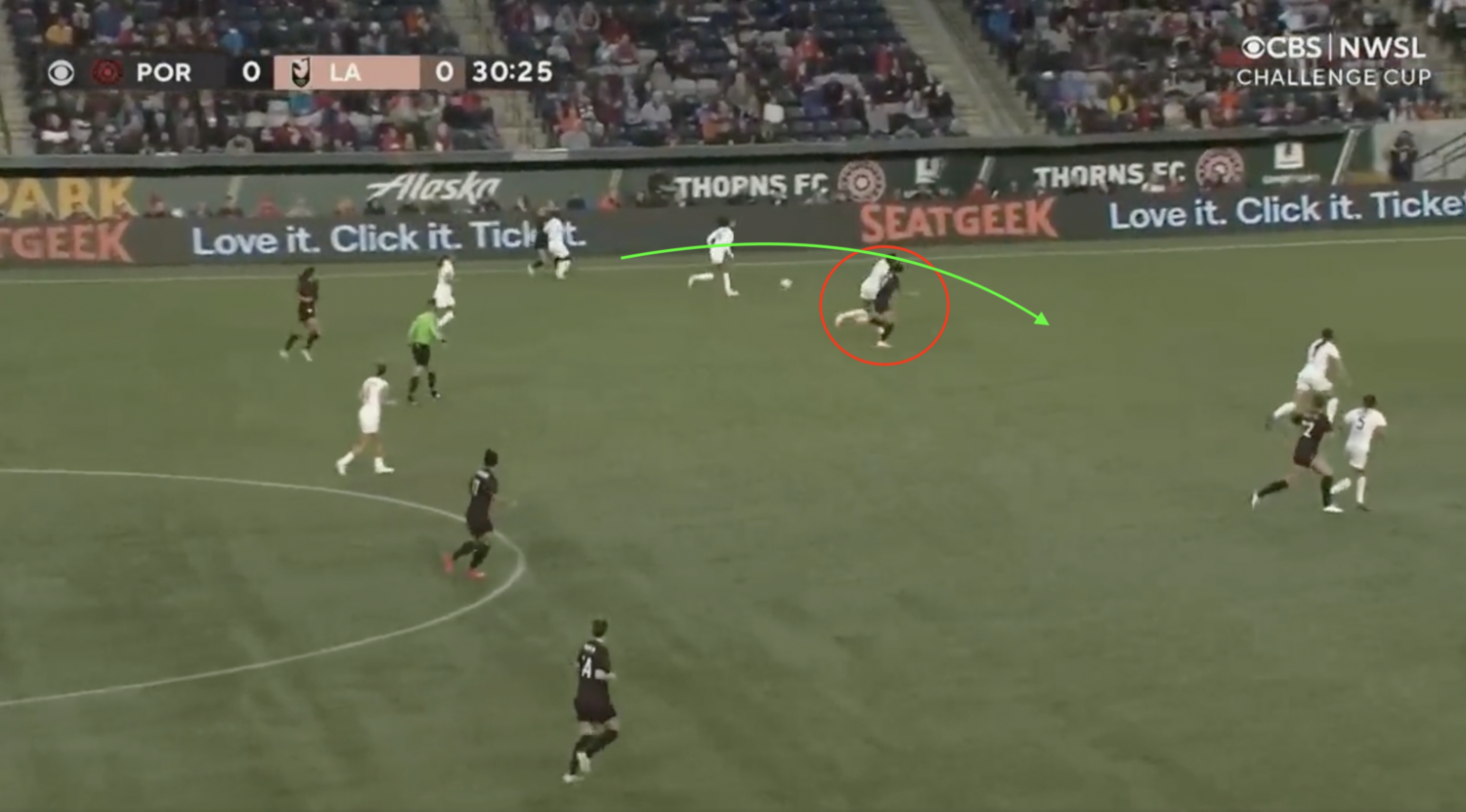
In the screen cap above, Sophia Smith is the red circle, and the green arrow is the trajectory of the ball played in by Natalie Beckman. Smith gets on the inside of her defender and has the pace to outrun her. If Beckman plays the ball too far ahead, or too hard, there are two Angel City defenders who are ahead of Smith to reach it first. With the quick movement of her hips and feet, Smith is able to fake out the defender on her shoulder and sit her down. From there, she has a clear path to goal.

When Smith reaches the inside of the penalty box, she is able to put the ball on her preferred right foot and deftly place it in the lower left corner of the net, out of reach of the Angel City goalkeeper. Postgame, Smith talked about how her shooting accuracy has been something she has developed through repetition, largely alongside Morgan Weaver. Seeing the fruits of training pay off in a game is very fulfilling.
Ryan scored the second goal off a rebounded bullet shot by Natalia Kuikka.
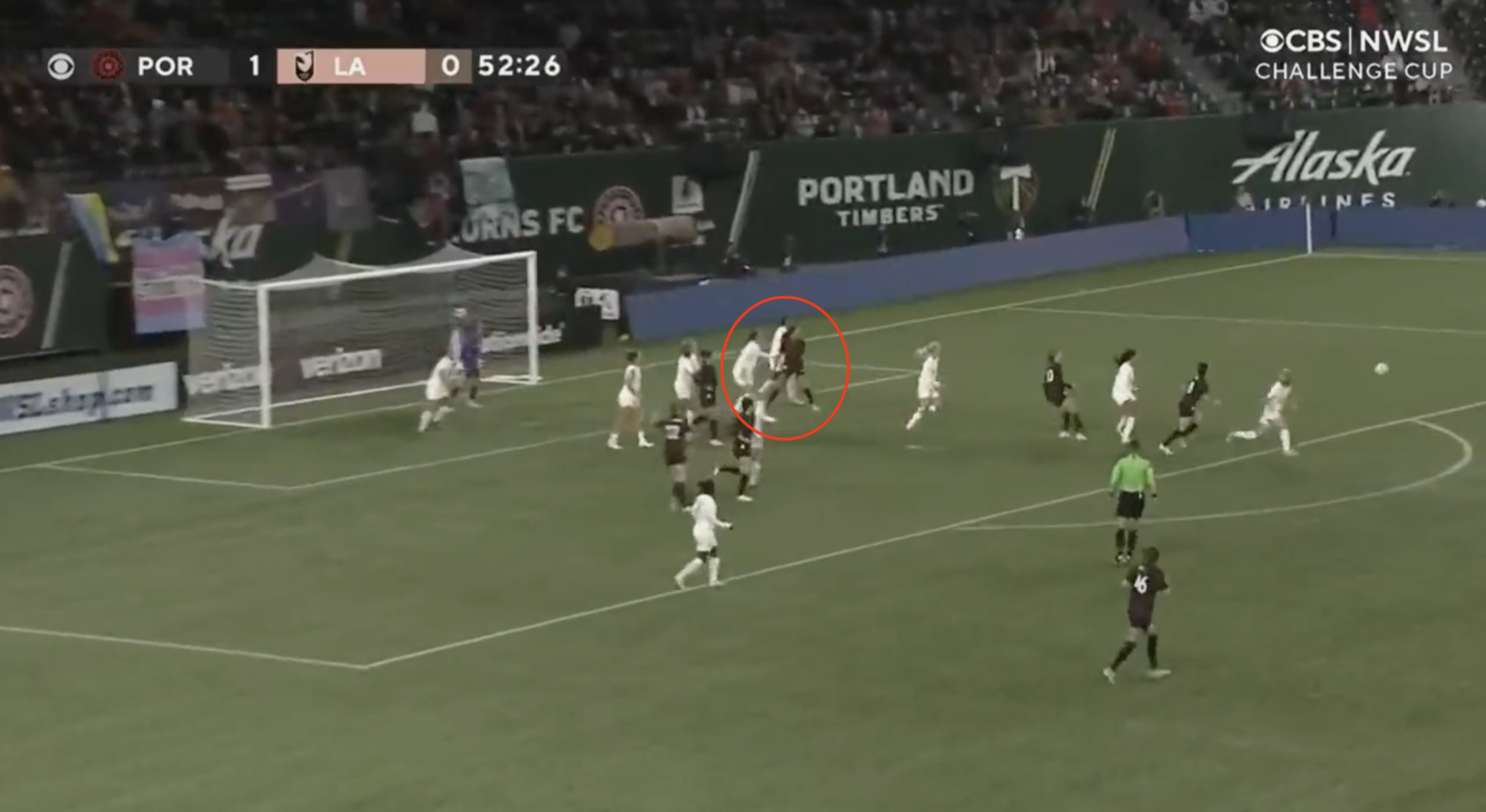
Ryan, circled in red, is watching Kuikka set up her shot. Once it goes off, she is able to turn on the inside of her defender and be prepared for the rebound. Her positioning here is what allows her to easily deflect the path of the ball into the back of the net. All of the Thorns were heads up during this play, with Kelli Hubly even with Ryan and ready to receive the ball if the initial shot didn’t make it.
Weaver recorded her first Thorns goal of 2022 in the final 15 minutes of the game.
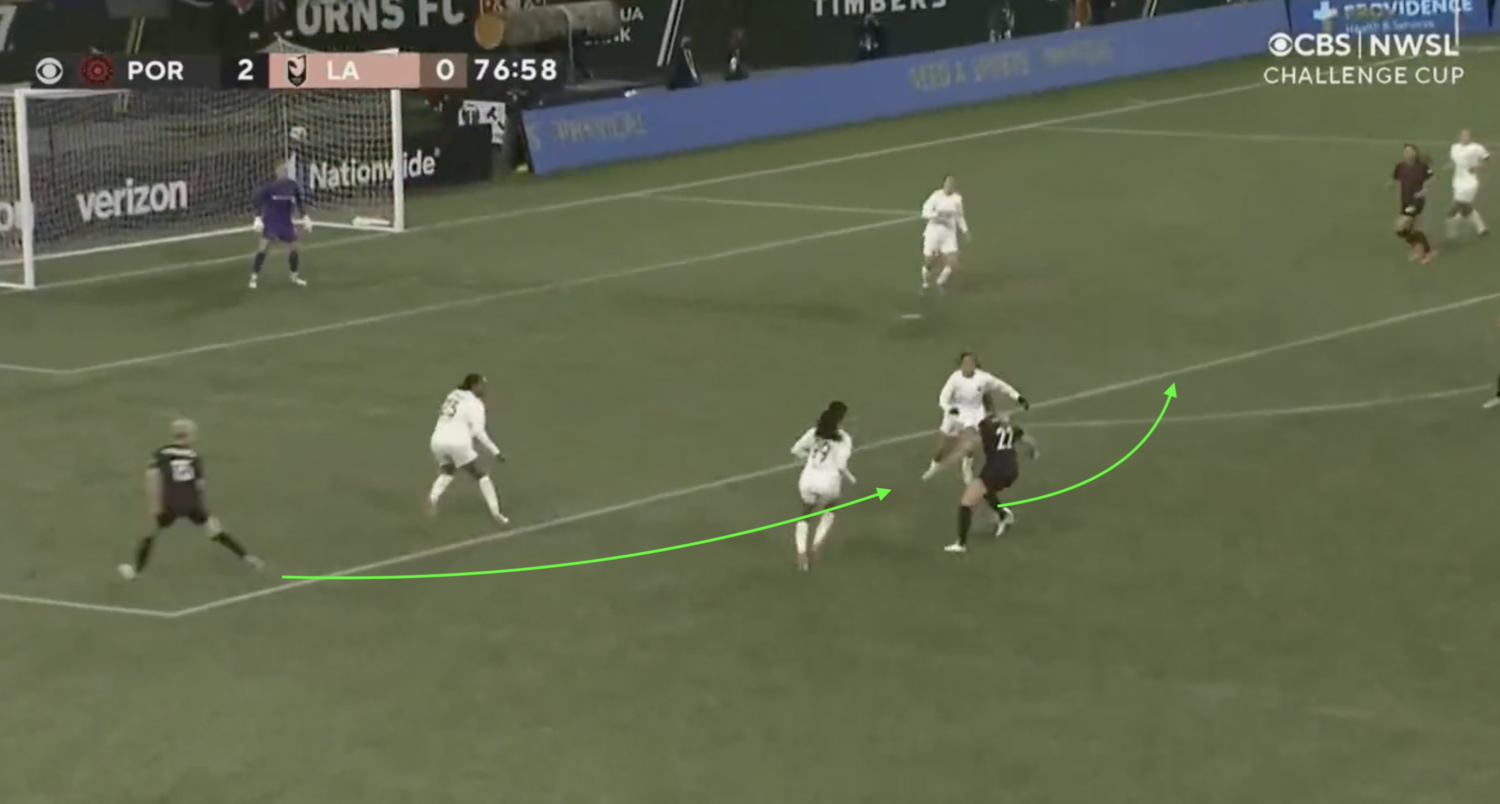
Madison Pogarch, coming back from injury and earning her first minutes of the year, was playing as a winger (finally one step closer to playing as a forward) and intercepted the ball high up the pitch. She controlled it, and passed it to Weaver at the top of the box. Weaver was able to swing the ball across her body into the open space in the arc. Both the defenders were crashing onto her left side, and by simply changing the direction, she was able to open up the entire goal. She then sent an absolute screamer curling into the side netting. Much like Smith, her goal is one that she has been repeatedly working on in practices and on her own time. As the season progresses, we can only hope that she will be prolific in front of goal.
Challenge Cup group play is halfway over, and the Thorns remain undefeated. As they go against each team in the West once more, the Thorns’ depth will be tested. But, if they keep finding the space in front of goal as they did against Angel City, they should end up with plenty of points from these next three games.
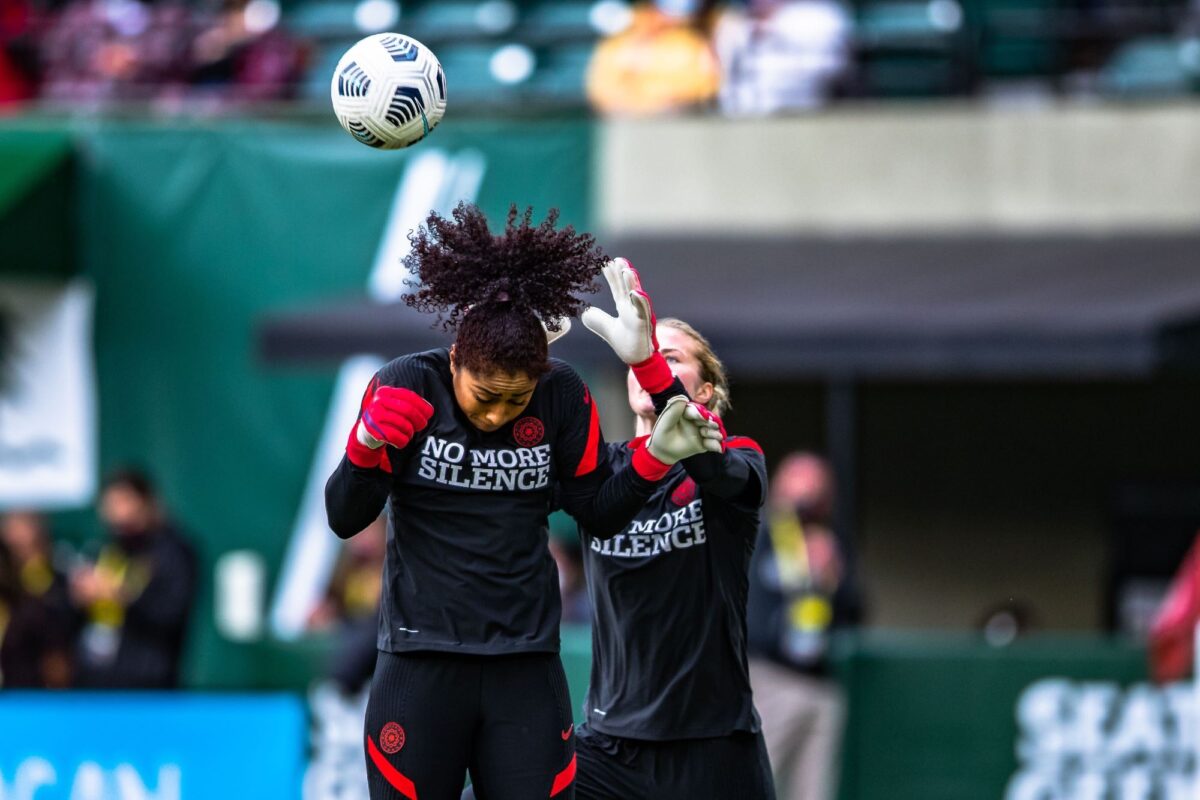
The Thorns look very different than when they stepped off the field in 2021, and two games into a preseason tournament, they are still finding their footing. Without being too critical of the team, there are plenty of bright spots to take away from the inaugural Thorns versus San Diego Wave game.
Saturday night’s game marked the professional Thorns debuts of Abby Smith and Natalie Beckman. Both players appeared in the preseason games and showed new head coach Rhian Wilkinson that they had valuable skills. Although Beckman only played about 10 minutes coming in for Klingenberg, she looked confident on the wing as part of the Thorns’ five-back and should be an exciting prospect in the games to come. Smith has plenty of NWSL experience, most recently for the Kansas City Current, but had yet to make an appearance for the Thorns since signing mid-season in 2021.
In her inaugural game, Smith registered seven saves and a clean sheet, making her the fourth Thorns keeper to record a clean sheet in a Challenge Cup match. The decision to start Smith over Bella Bixby, Thorns No. 1, was a collaborative one between head goalkeeper coach Nadine Angerer, Bixby, and Smith. Head coach Rhian Wilkinson said post-game that it was Bixby’s suggestion to have Smith play so that Smith has the minutes and confidence to fill in when Bixby is unavailable. Smith also spoke highly of the Goalkeeper Union in Portland and how all keepers push one another and inspire greatness. With such a solid culture in goal, any of the Portland keepers should be able to control the backline.
Saying that Sophia Smith is good at soccer is probably the understatement of the year. Her technical skill and ability to get in behind the backline has already proven to be crucial to the Thorns’s attacking strategies. Sinking three out of three shots on target, Smith is lethal in front of goal. However, in the game against the Wave, Smith showed that she is more than just a pacey striker. In the run up to the Thorns’s lone goal, Smith was able to draw out three San Diego defenders to surround her, leaving both Natalia Kuikka and Christine Sinclair with plenty of space on the wings to send a ball in that Smith hit one-time deftly around Sheridan.
Post-game, Wilkinson had high praise for Smith. She cited that Smith not only has a high ceiling that she delivers on, but that she is able to quickly implement feedback. One thing that Smith and Wilkinson are working on is “when to go in behind defense on transition and when to hold back to create different types of scoring opportunities.” With the combination of skills she possesses, it is a no-brainer that Smith will be a crucial member of the Thorns this year.
Sam Coffey, Yazmeen Ryan, and Meaghan Nally all got the start on Saturday. With Becky Sauerbrunn out after undergoing surgery to repair her meniscus, Nally has been able to slide into a starting role on the backline. She didn’t look out of place in the slightest alongside veteran defenders Emily Menges and Kelli Hubly, registering the highest number of touches and completed passes of the three.
Ryan and Coffey, alongside Hina Sugita, are working to rebuild the midfield that the Thorns lost in the offseason. Together, the two young players in their first full season with the Thorns have already impressed. As the holding midfielder No. 6, Coffey had nearly an 80% passing completion rate. She was able to exploit the wide open spaces left by the non-existent Wave midfield, and looked as though she controlled the field. As she gains more experience and confidence on the field, she will be a real force to be reckoned with. Finally, Ryan also worked hard in the midfield, completing several successful dribbles to bring the ball into the final third, playing in Smith. As both Sophia Smith and Ryan get more time together and their partnership solidifies, they should be a lethal duo on the left.
The Thorns go again tonight at home for their inaugural match against Angel City FC as they continue their run to secure their second Challenge Cup championship.

It’s Challenge Cup time again, and the Thorns opened their tournament on Friday with a 1-1 draw to OL Reign. Even with a couple missed chances, it wasn’t a bad start to Portland’s first non-preseason game of 2022—and it left us with a lot of positives for what this team can become.
The Thorns are generally a team that have high expectations for themselves—take just last year, when they set out with the goal to “win everything”—and they’ll want better than a draw. But with a new team and a new head coach and a number of key players out, I don’t think we can read the team’s performance or the game’s outcome as a bad result.
Thorns head coach Rhian Wilkinson put it best in the postgame press conference. “I thought the team put in a performance, in a lot of ways, that we can be proud of,” she said. Although she said that Portland has room to grow, and that they did miss a couple good opportunities, “they gritted out a tie, and winning teams get points on the road. I was really proud of that piece of it.”
Not only did the Thorns pick up a draw, but they did so without the likes of Crystal Dunn, Madison Pogarch, Rocky Rodríguez, and Becky Sauerbrunn.
Those absences—along with the temporary departure of Lindsay Horan and Angela Salem’s retirement—meant Friday night’s Thorns were in a very different position from last year. Instead of leaning on an internationally-experienced midfield that had at least a couple years in Portland’s system under their belt, the Thorns started relatively young midfield that hadn’t really played together before. Hina Sugita and Sam Coffey—while both clearly very talented—are new to the team, and Yazmeen Ryan played less than 400 minutes in the regular season last year.
It’s not surprising that it took the Thorns a second to settle in. In the opening minutes of the match, Portland looked happy to give the Reign time on the ball, sitting back using pressure to force OL to play out of the back.
In Sauerbrunn’s absence, the Thorns also started Meaghan Nally in defense, who had played 19 minutes for Portland in 2022. Despite a dodgy moment early on, she grew into the game and helped hold Portland to one goal against. Wilkinson called her “unflappable” after the match.
“It took us a second to get organized and communicate a little bit better,” Christine Sinclair said after the match, “but I think we figured it out pretty quickly.”
Even though it was fun to watch Portland’s midfield settle in and more effectively contain world class players like Jess Fishlock and Quinn, I’m not sure how much to read into that performance. Rodríguez, Dunn, and, presumably, Horan will be coming back into the fold as the season progresses, and I won’t be surprised if Wilkinson experiments with formations as she and the players get used to working with each other. Still, Coffey, Ryan, and Sugita all put in solid shifts on Friday, and I’m excited to see how they develop as the season progresses.
“We’re definitely up for the challenge,” Sinclair said, “and we’re only going to grow more and more each game.”
And as the Thorns grow into this new iteration of the team, they’ll still have the likes of a number of more experienced players to lean on. Sinclair, Natalia Kuikka, and Sophia Smith showed as much with the goal they worked to create against the Reign.
Sincy on the spot. #BAONPDX | #NWSLChallengeCup pic.twitter.com/sqm1d1cwHd
— Portland Thorns FC (@ThornsFC) March 19, 2022
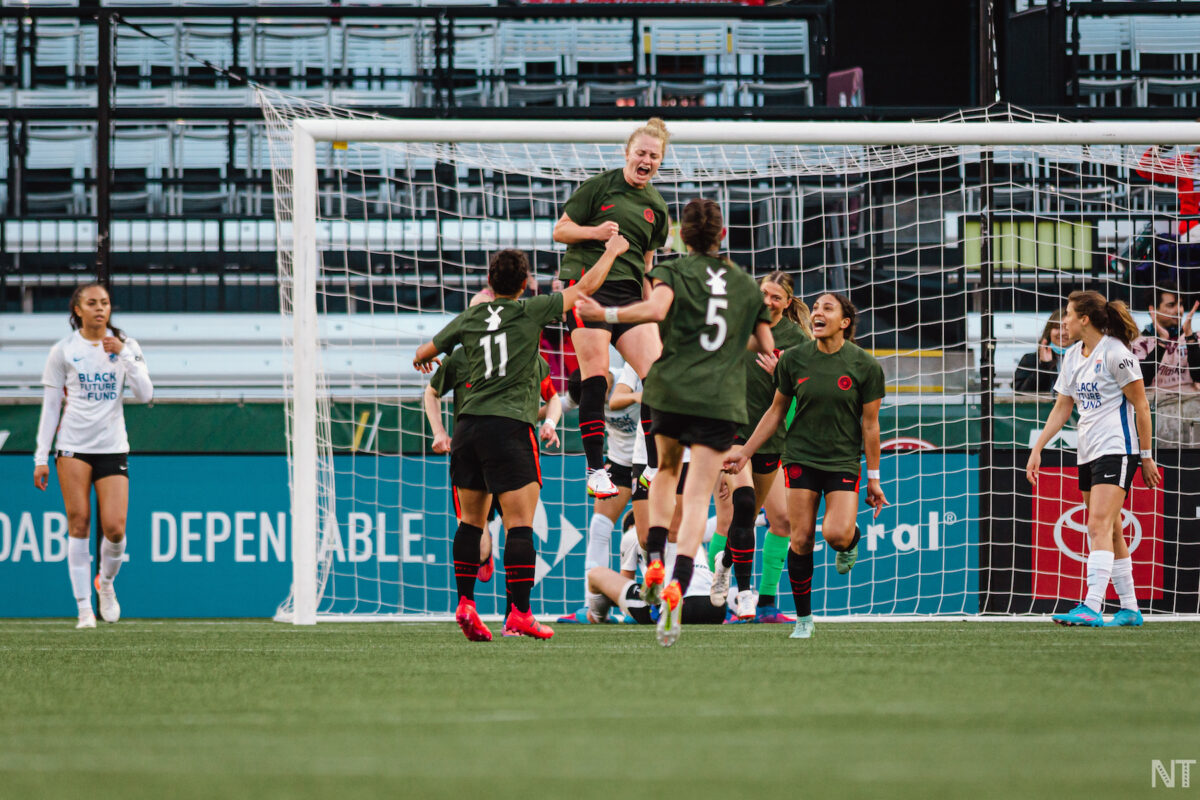
The Thorns have their first open-door match of 2022 on the books in the form of a 0–0 draw against OL “ol’ Reign” Reign. Rhian Wilkinson’s first game! The Thorns wore green! Let’s talk about it.
With Lindsey Horan gone, the Thorns have no choice but to come up with a completely new system. I’m not sure most fans are really prepared for what losing Horan means, which may be partially my fault and that of my media peers, since I don’t know that we’ve collectively emphasized enough how pivotal she was in the Mark Parsons era. So, to be clear: having Lindsey Horan is like having an extra player on the field. She’s a living cheat code. She was such a presence for the Thorns that she was almost easy to take for granted, like the sun.
It’s not that Portland never got results without her—the clashing NWSL and international schedules meant they had to do that plenty of times when she was on the roster—but I get the sense that the collective awareness of her importance was almost unconscious. Her contribution to the team wasn’t scoring worldies as much as it was that she’d show up and everything on the field would suddenly work better. The discourse when she was available wasn’t “Horan looked good today,” it was, “the Thorns looked good today.”
All this is preamble to the fact that Wilkinson is doing something very, very different with this team. The squad lined up like this:
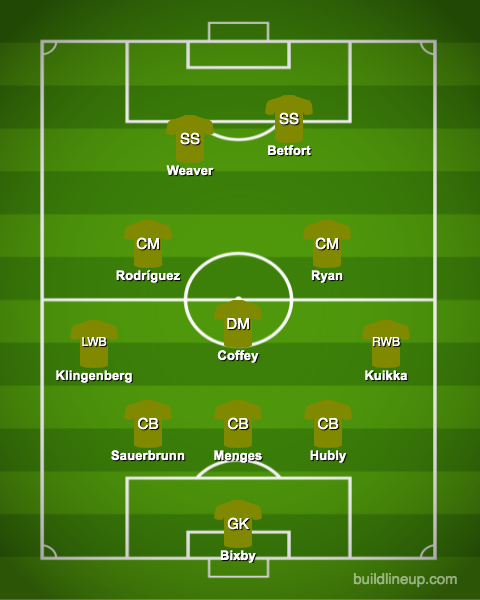
In a word, the game was unspectacular. Whenever they lost possession, the Thorns would drop straight into a neat block; Morgan Weaver and Hannah Betfort would pester a center back or two to keep things moving, but the counterpress of the Parsons days is long gone. Natalia Kuikka and, to a lesser extent, Meghan Klingenberg, played pretty defensively, spending more time cutting off Reign attacks up the wing than looking to go forward themselves. Sam Coffey sat in a sharply defined No. 6 role, using none of the creativity she displayed at Penn State. Postgame, Rhian Wilkinson had this to say about using Coffey in that role:
Sam, even when I first brought her in, her calmness on the ball—she’s got ice in her veins. She’s been like that since day one, just like, “give me the ball.”… In that way, I really believe in midfield strength and connection. And I like her at the six, I think that she really comes alive, and she connects our team. We have a number of players that can do it. But I wanted to put her in the fire really, and see how she did. And I think she gave you all a glimpse of the talent that she has.
Thorns attacks were sparse, with a handful of chances in the first 15 minutes, then another handful in the last half hour. An early goal by Betfort—a header from close range off a corner by Weaver—was waved off for a foul. Most of the chances came from exploiting the spaces left open by Seattle’s press, with Kelli Hubly and Becky Sauerbrunn both connecting directly with the forwards a few times.
Betfort is listed as a defender, but Wilkinson says she sees her as a striker, and had this to say when comparing her with the other forwards on the roster:
Morgan and Sophia Smith are pure athletes. They’re incredible with their feet, technically, as well. Hannah has also got a lot of speed… the other two have a little bit more quickness, she has pure speed. And she’s very obviously a big strong woman who holds the ball out well for us. And she’s got clean feet for someone who is sort of one of those air quotes “old-school” kind of nines, as holding the ball up, she’s got really tidy feet. And I think she likes to play in a different way, where the others pull the line back, she often comes off the front.
The Thorns haven’t had a good old-fashioned shit-kicking nine in some time, and I enjoyed watching Betfort in that role.
In the midfield, Portland often looked outmatched. They were visibly frustrated with the Reign’s press, and Rocky Rodríguez and Yazmeen Ryan struggled to get past Quinn and Jess Fishlock. They’re both excellent creative players, but with a No. 6 who isn’t tasked with contributing much to the attack, no No. 10, and two forwards who tend to stay forward more than drop back to connect play, they couldn’t build much out of the center of the field.
But what we saw last night is not Portland’s best XI. Hina Sugita got about ten minutes in the No. 8 at the end of the match, about which all I have to say is: everybody new to the NWSL has to get that initiatory “why are they like this” moment out of the way. Smith came on in the 74th minute looking sharp as hell and immediately improved the connection between the midfield and the forward line. Also, Crystal Dunn will not be pregnant forever.
The defense was last night’s strong point. Hubly, Sauerbrunn, and Emily Menges are an outstanding central trio and contained just about everything the Reign threw at them. Whatever hiccups happen with the front five as the season gets rolling, Portland will be able to lean on that defensive foundation for results.

Note: this article contains transphobic and racist social media posts, including a manipulated photo showing a person in blackface, and discusses racist, transphobic, and anti-semitic right-wing rhetoric and violence.
You’ve heard, I’m sure, that the Portland Thorns—the organization currently led by two very nice Canadian women, one of whom said in her introduction to the press that she wanted to create “the most connected, purpose-driven club in the world”—chose a player named Sydny Nasello out of the University of South Florida in this year’s college draft. I imagine you’ve also seen the social media activity fans dug up the instant her name was called. In case you haven’t, here are some screenshots:
I don’t know Nasello. I don’t know, when it comes down to it, exactly why she chose to retweet these things, nor do I know if her views have changed since the most recent one above, from November 7, 2020. But I have spent enough time on the internet to know that retweeting usually serves the purpose of amplifying a message that a user agrees with, and I am aware enough of our current political moment to know that these particular posts suggest a specific worldview. Everything I am about to say is based on that information.
Working with the assumption that retweets mean endorsement, let’s consider the three above one at a time.
The first one indicates that the retweeter denies the reality of trans identity. This is a belief so obviously harmful that it requires no further explanation.
The second one is a little harder to parse, but here I feel that a bare retweet, with no added comment, implies the retweeter has a positive view of the little boy raising money to build a 30-foot wall on our southern border.
The last one, by the former president’s greasy-haired son, no less, alludes to the widespread pro-racial justice, anti-police protests in the summer of 2020, equating anger over centuries of well-documented state-sanctioned violence against Black people with anger over an election that some people believe, without evidence, was stolen. It also alludes to baseless conservative claims that racial justice protesters turned many cities—Portland included—into smoking, lawless ruins ruled by roving antifa gangs.
If our assumption that the retweeter agrees with these things is correct, her views are firmly in line with those of the archetypal Trump voter. Not the reluctant fiscal conservative, not the ordinary rich person who doesn’t want to pay higher taxes; the flag-waving, grievance-driven fanatic.
These tweets reflect a worldview basically reducible to a single principle: no person or group of people has an inherent right to exist, much less the right to be treated with dignity and respect, to express themselves, to participate in the political process, to have complete bodily autonomy, to move freely, or to form associations with others as they choose to do so.
This view denies trans people the legitimacy of their lived and felt reality, denies people uprooted by conflict the right to seek asylum, and denies people living in extreme poverty the right to be treated like human beings at all. To people whose views are in line with these tweets, those rights are only accorded to those with the means to seize them, whether by physical, economic, or political power. To the extent that any person or group of people cannot do so, even (or perhaps especially) if that inability is caused by longstanding institutionalized oppression, this is taken as evidence of inherent inferiority and unworthiness not just of those rights, but ultimately of continuing to live.
Conveniently, there’s a word for this world view: fascism.
Again, it’s impossible to ascribe, with absolute certainty, a set of beliefs to someone you’ve never met, but everything I know about the world leads me to believe that someone who would amplify these messages on their personal social media probably thinks this way, broadly speaking.
A couple hours after she was drafted, Nasello tweeted a Notes app statement containing the kind of non-apology apology we expect from public figures who have been caught expressing views they still wholeheartedly embrace but fear will get them “canceled”:

Nasello can play coy all she wants. She can come up to the teacher’s desk and say “I’m sorry if I offended anyone” with her eyes shyly lowered while she fidgets her hands behind her back. But we all know, and I imagine she knows, that she’s dodging the real issue. The problem is not that she might, at some time, have made some abstract group of people feel “not supported.” The problem is that she has deliberately and repeatedly indicated that she believes some groups of people are inherently less valuable than others. If she does not hold that belief, I don’t know why she would have retweeted Charlie Kirk saying as much. If she’s changed her mind since then, surely she could have said so specifically in her statement.
There are also two Twitter “likes” by Nasello’s account that I want to highlight:
These stand out to me not because they express particularly more extreme or dangerous views than the three retweets I included above, but because of their tone. To me—again, because I have spent a fair amount of time on the internet and can recognize alt-right rhetoric—they add a particular hard edge to the basic outline illustrated by the retweets discussed above.
They are noteworthy because they exemplify what is perhaps the most terrifying aspect of the radical right as it currently exists in America: the way that to the extreme right’s adherents, all of this, the casual cruelty and dehumanization and undermining of democratic norms, is a big fucking joke. The modern right was birthed on the internet, by millions of people memeing about things like the Holocaust, trying to outdo one another in edginess, screaming racial slurs on Xbox Live, all for the lulz at first, until at some point the joke became, “let’s stage a torchlight march where we chant ‘Jews will not replace us,'” and the punchline had a body count.
Once again, I do not know Nasello’s intention here, but I think it’s fair to say that the act of clicking what’s called the “like” button usually indicates agreement or appreciation. So: in that light, let’s consider the two tweets above.
I will confess that I’m not sure what the joke is supposed to be in the first one. In part, it seems it’s simply intended to be shocking for the sake of being shocking. One point being made is that anyone (“libs”) who would feel belittled or insulted (“offended” or “triggered”) by blackface is clearly an idiot and therefore that blackface is inherently funny; all the more funny to portray one of the country’s best-known left-wing figures, a woman who presumably understands why blackface is harmful to Black people, wearing it.
There’s some second layer here, too. At the end of 2020, LeBron James’s longtime contract with Coca-Cola ran out, which I assume is the reference being made. I suppose we’re intended to make some connection between Black people (because James is Black, get it?) and Coke, something about how brands have given in to the Woke Mob and will now only endorse people of color. I think? If I’m right about that connection, there’s an added element about James being not just a very rich and famous Black man, but one who is fairly outspoken about racism, which racists do not like.
The joke is nonsensical, as far as I can tell, but in short, it mocks 1) the idea that racism is bad, 2) Alexandria Ocasio-Cortez thinking that racism is bad, and 3) corporations wanting to appear not to be racist.
The second tweet isn’t a joke so much as an exemplification of the way the online right expresses approval of its heroes, in slangy terms that gesture toward irony but, as with everything in this world, are anything but. Beating an antifa protester with a stick is termed “based,” while here Trump’s ultranationalist chest-thumping amid a deadly pandemic his administration exacerbated is “hard.” He’s just another memelord, in this view. Calling migrants rapists and criminals is a meme, sexual assault is a meme, racist violence is a meme.
That the views expressed in the posts I’ve included here reflect the outlook of a larger and larger majority of one of the two mainstream political parties in this country is irrelevant to the fact that this outlook is straightforward, by-the-book fascism. This is the single most vile and dangerous ideology that human beings have ever invented, and it’s here right now, and we cannot pretend that we don’t see it.
For the third time, let me reiterate that I don’t know Nasello, so to some degree, all this is conjecture. I think, however, that it’s quite reasonable, as conjecture goes.
And I want to be abundantly clear about the appropriate answer to a person who espouses this kind of extreme right ideology. There is no room for tolerance when it comes to fascism. Fascism is about power, and its proponents do not deal in good-faith dialogue and debate. This set of views is so dangerous not only because it involves wishing harm on certain groups of people; the additional danger is that it seeks to perpetrate that harm through the destruction of the democratic process and anyone who dissents. If we let ourselves be drawn into a facetious discussion about the legitimacy of these views, pretending that somewhere between “we should overthrow the government and install a white nationalist autocracy” and “all human beings are inherently valuable” lies a reasonable middle ground, we’ve already lost.
The Thorns say they didn’t know about all this before drafting Nasello. Fine; I have no reason not to believe them. That’s a serious unforced error, but fortunately it has a simple solution: the Thorns must release Nasello’s rights. An organization cannot seriously claim to respect the rights of women, Black and brown people, and the LGBT+ community while allowing someone with these views onto its payroll. In the Rose City, there is no football for fascists.
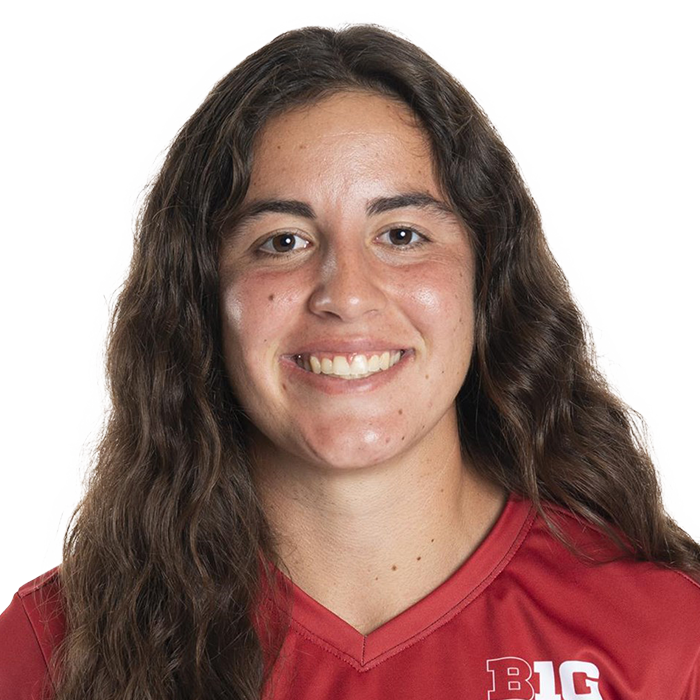
Coming off of their strong 2021 season, the Thorns are retaining their core players, and weren’t looking for players in the 2021 NWSL college draft to make an impact right away. With a successful history of developing college players, the Thorns went for players who could add depth to their already deep roster. Here’s a rundown of their selections:
Nasello has a public history of racism, transphobia, and xenophobia, which doesn’t with the “open” and “inclusive”—as new head coach Rhian Wilkinson described the team yesterday—culture on the Thorns. We’ll get into that more in a separate piece, but for now, her merits as a field player need to be evaluated separately.
A two-year first-team All American, Nasello has many personal accolades to her name. As a No. 11 forward at the University of South Florida, she had a 41% conversion rate, scoring 11 goals in the 2021 season. She is a strong passer and creates plenty of chances off a dribble. USF is consistently battling for the top of the American Athletic Conference (AAC), and Nasello has scored four game-winning goals to help send her team to the top, winning offensive player of the conference two times. USF lost in the first round of the NCAA tournament, which prevented Nasello from exhibiting her talents on the national stage. In order to fit in with the Thorns’ play, she will need to improve her crosses so as to not be wasteful in the final third. She will need to mature quickly to fit in with the Thorns, both on and off the field. Despite her stats, I don’t rate Nasello.
Rutgers has proved a successful college for the Thorns to draft from, with Madison Pogarch—along with the now-traded Amirah Ali—attending the school. Rutgers made it to the NCAA College Cup, falling in the semi-final game to eventual champions Florida State. Provenzano played primarily as a center back, a position where she can learn from The Great Becky Sauerbrunn and Emily Menges. An excellent passer, Provenzano boasts an 86% pass completion rate. Provenzano has received numerous individual awards throughout her time at Rutgers, recently earning All-American, Big 10, All Region, and NCAA College Championship first team honors for her role on the back line. Taking her fifth-year of eligibility due to COVID-19, Provenzano captained Rutgers for three seasons. Despite her holding-down of the backline aiding shutouts, she has posted five goals over her 103 career games. With both proven leadership and solid stats, Provenzano could be a great impact player for Portland—and has a high ceiling to grow.
Beckman is an excellent pick late in the draft. She has posted incredible stats throughout her four years at University of Denver and has the potential to grow into an impact player if she gets a contract with Portland. While Beckman has posted 21 career goals, her 47 assists set a college record. Her crosses are always spot on, and her 78% passing completion rate confirms this. In a system with talented strikers like Morgan Weaver and Sophia Smith, Beckman could prove valuable in feeding balls into the attack. An All-American second-teamer, Beckman helped lead Denver to Summit League champions three times. Beckman is also a competent dribbler, able to get into tight spaces and get crosses off at the endline. She is a two-time Summit offensive player of the season and a two-time offensive player of the region. Playing in an elite-level system like the Thorns will help aid Beckman’s development greatly.
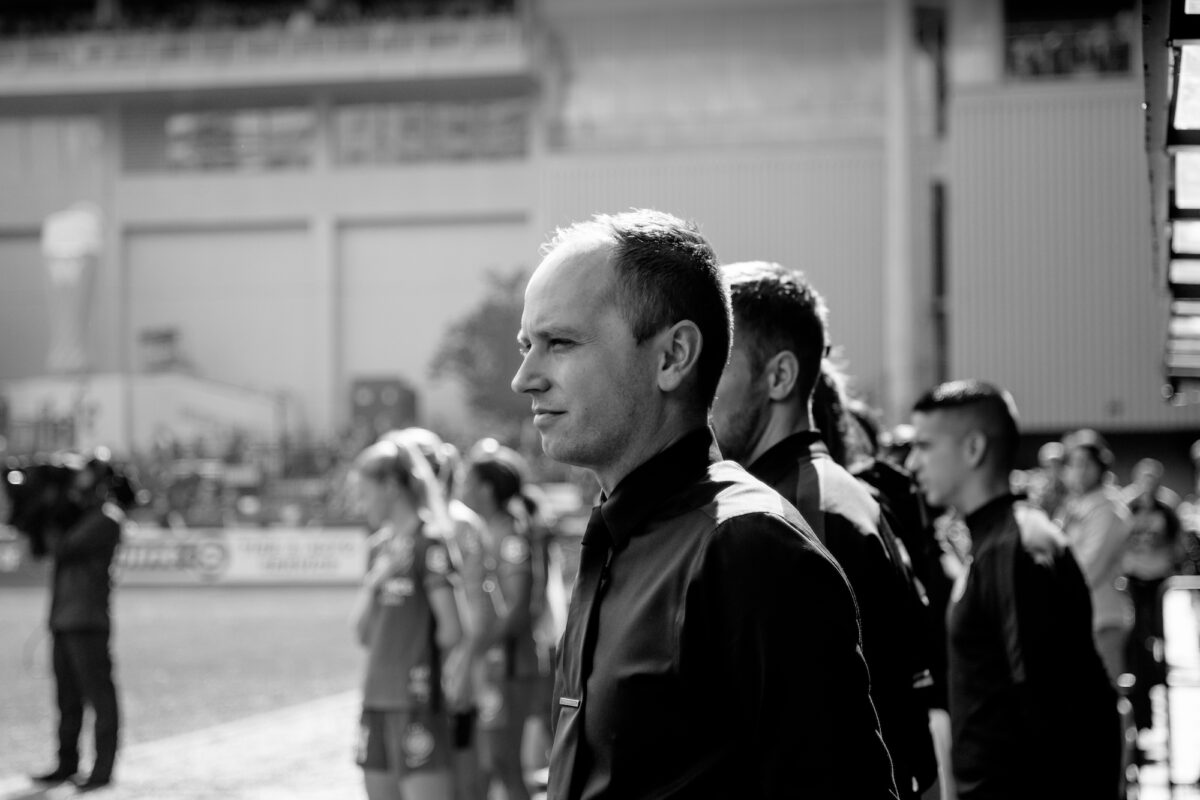
I tried to write about Mark Parsons, who recently completed his sixth and final season as the coach of the Portland Thorns. It didn’t work. Instead I just thought about the passage of time and my experience of it. That’s what this is:
I was 16 the first time I felt old. I was in the hall at South Eugene High School and something involving a slightly younger person happened—I have completely forgotten what—but I remember with crystalline clarity that suddenly I felt like this:
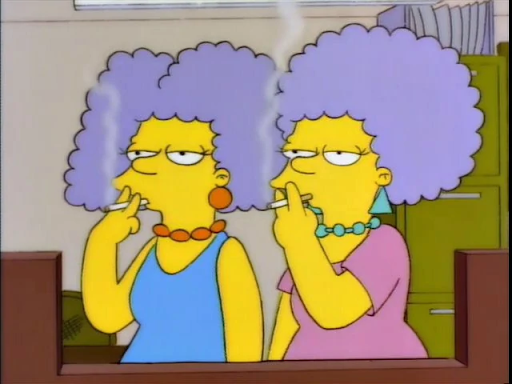
It’s absurd to feel old at 16, or perhaps any of the ages that I have been thus far. But the essence of feeling old has nothing to do with objective age. It’s about being old-er. Thus, it is possible to feel old at almost any age. One of the main ways to feel old is what I felt in the hallway that day: realizing that you know things that younger people do not.
Sometimes you look at a younger person and think, “How could you care so much about [thing]?” Sometimes you look at them and think, “Good lord, don’t do that.” Sometimes, a little cruelly, it’s “Just wait until [bad thing happens].”
The other face of feeling old (aside from mysterious bodily pain, which I would not experience until some years after the hallway incident) is the sense that the world and the people in it have shifted under your feet. You drive by a house you used to live in and it’s been painted and had all the leaky windows replaced, or it’s not a house at all anymore, it’s a condo. You go to a Thorns game and it hits you—feeling old always hits you all at once, never incrementally—that there are only two players on the roster who were there when you started your foolish little hobby of writing about them whether anybody wanted you to or not.
This is all a roundabout way of saying: things change. The “they knocked my old house down” feeling and the “what do you kids know” feeling are two sides of the same coin. Something goes away, something else gets renewed. Everything dies, and the wellspring of youth is infinite. That’s all you can count on.
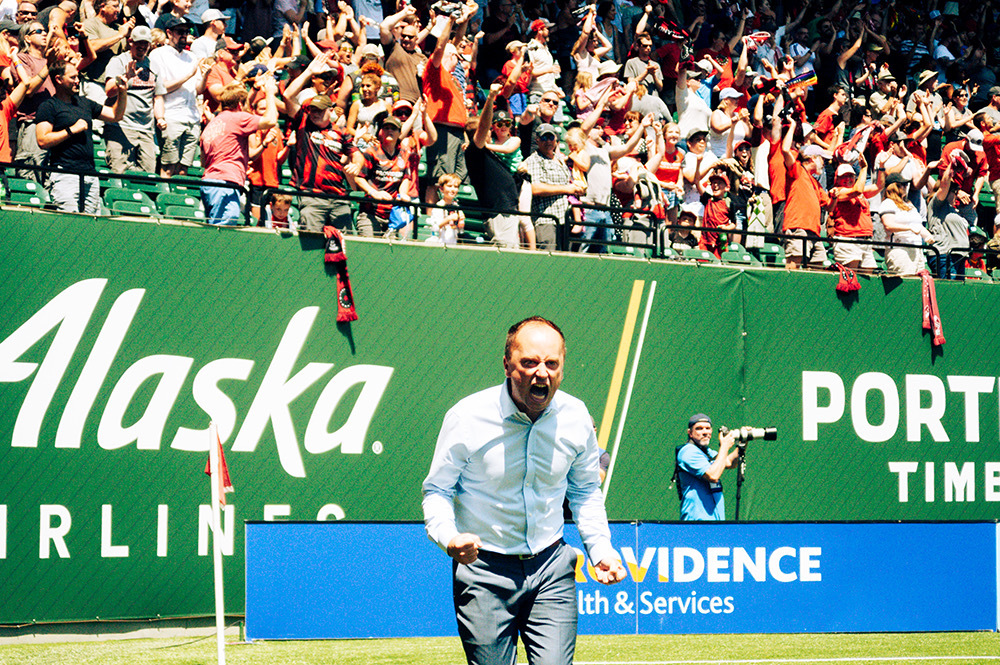
Where is the essence of a soccer team to be found? Is it in the players? The stadium? The manager? The ownership? The fans? Clearly not: almost all of those things have changed for the Thorns over the last six years. If they are all changeable, how can we say that a club that exists today also existed nine years ago? 20? 100?
During the pandemic, I aged a good 10 years. That was the effect of more or less sitting in my house doing absolutely fuck all for something like 15 months. What I mean is that the experience was ultimately good for me.
For instance, one night last spring I realized that I’d been waking up with a vague fear tickling at the corners of my mind every day for months. Upon reflection, I realized that the fear was the fear of death, that it was probably time to deal with that fear head on, and further, that nothing in my life had given me the tools to do so. I decided to look for God.
In that hallway at South Eugene High School, 15 years ago (15 normal Earth years, not 15 pandemic years), I’d never have believed I would one day write that sentence. But I’m not that old-feeling 16-year-old anymore. You sit around long enough, becoming incrementally more Patty-and-Selma-like all the time, and eventually you might realize that the question—the question, the only question, the burning, impossible question—isn’t “does God exist,” or “what am I supposed to do while I’m here,” but “why is there something instead of nothing?” The answer to the question, which is unanswerable, is the thing we call “God.” That is what I have come to think, anyway.
I bring this up because 1) becoming curious about the nature of the universe was what led me, in a roundabout way, to the title and structure of this article, and 2) to illustrate that things will happen to you that you don’t expect. You will change in ways that might not make sense. This is both wonderful and terrifying: wonderful because it means that you are never stuck one way; terrifying because it also means that there’s no “you” to speak of, really. Not one that persists, or is under your control.
The me I was in 2007 is no more or less me than the one I was when I started to think about death last spring. The only one that exists at all is the one typing these words right now.
The Portland Thorns, too, are only ever exactly as they are in a given moment. There’s no higher level of abstraction. At one moment in 2016, they were this:
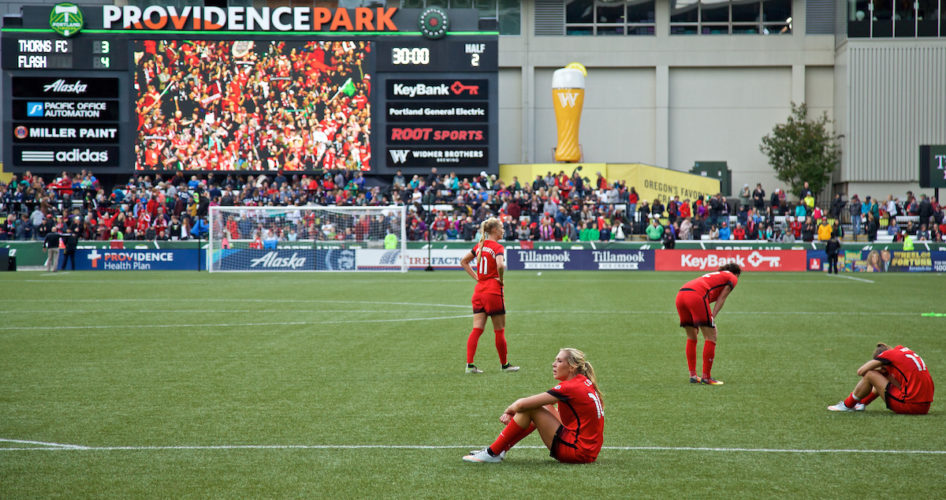
Once earlier this year, they were this:
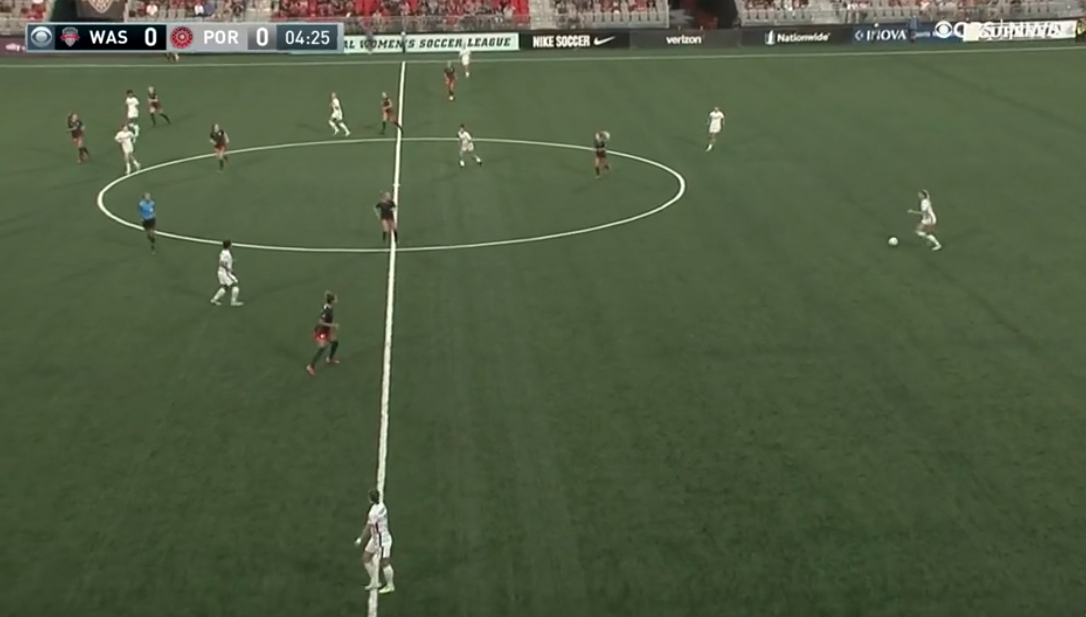
Another time, they were this:
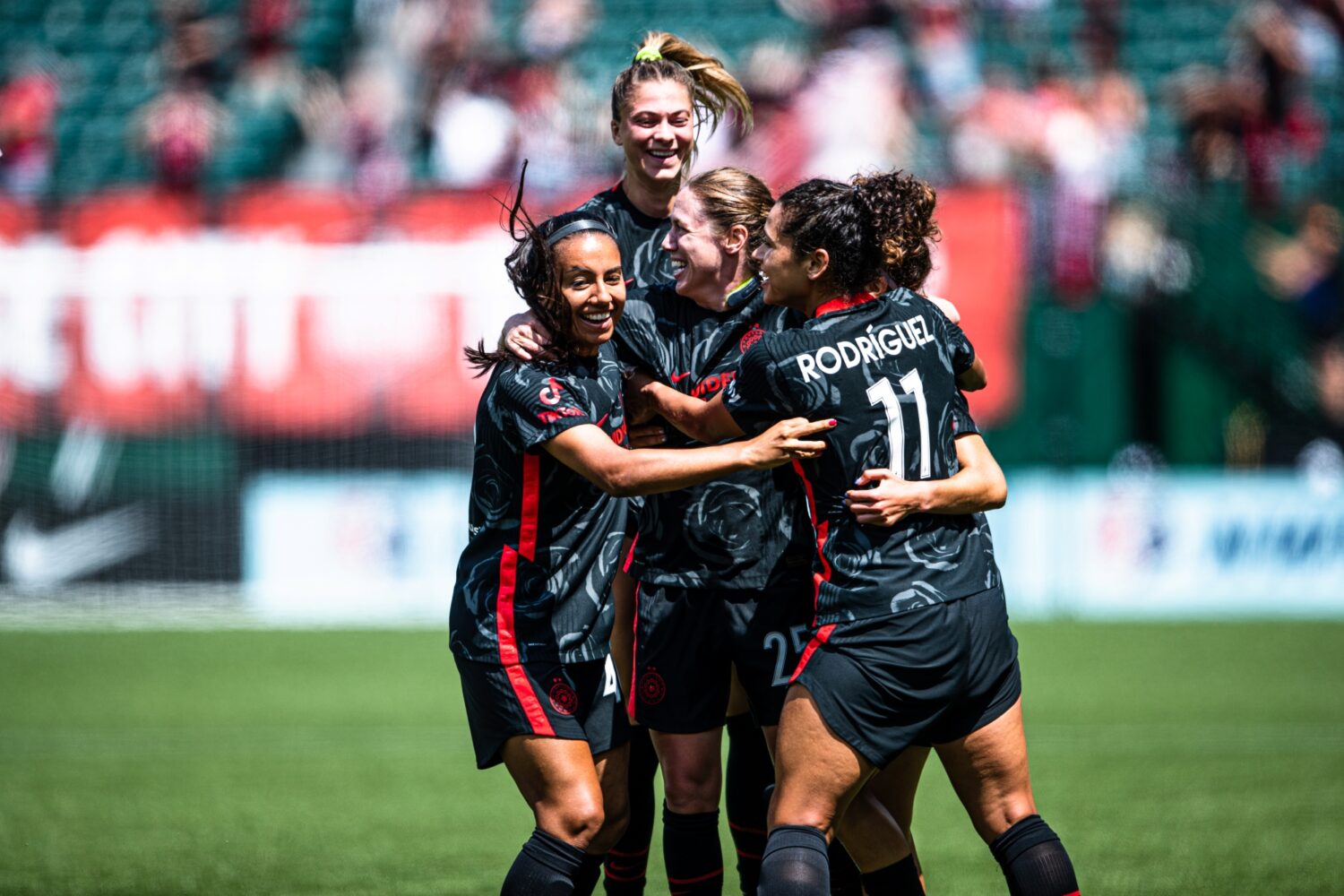
So right at this moment, what are the Portland Thorns? Where can I go to see them?
Inevitably, we have to conclude that they do not exist. We use their name as a semantic convenience, but it does not point to any continuous thing. The Thorns are not Mark Parsons, AD Franch, Midge Purce, or “Iko Iko”. Nor are they Sophia Smith, a big red drum, Gavin Wilkinson, Rhian Wilkinson, or even Christine Sinclair. They are not a pressing team or a counterattacking team. They are not defensively sound, nor do they have trouble finishing. They are simply there, or not.
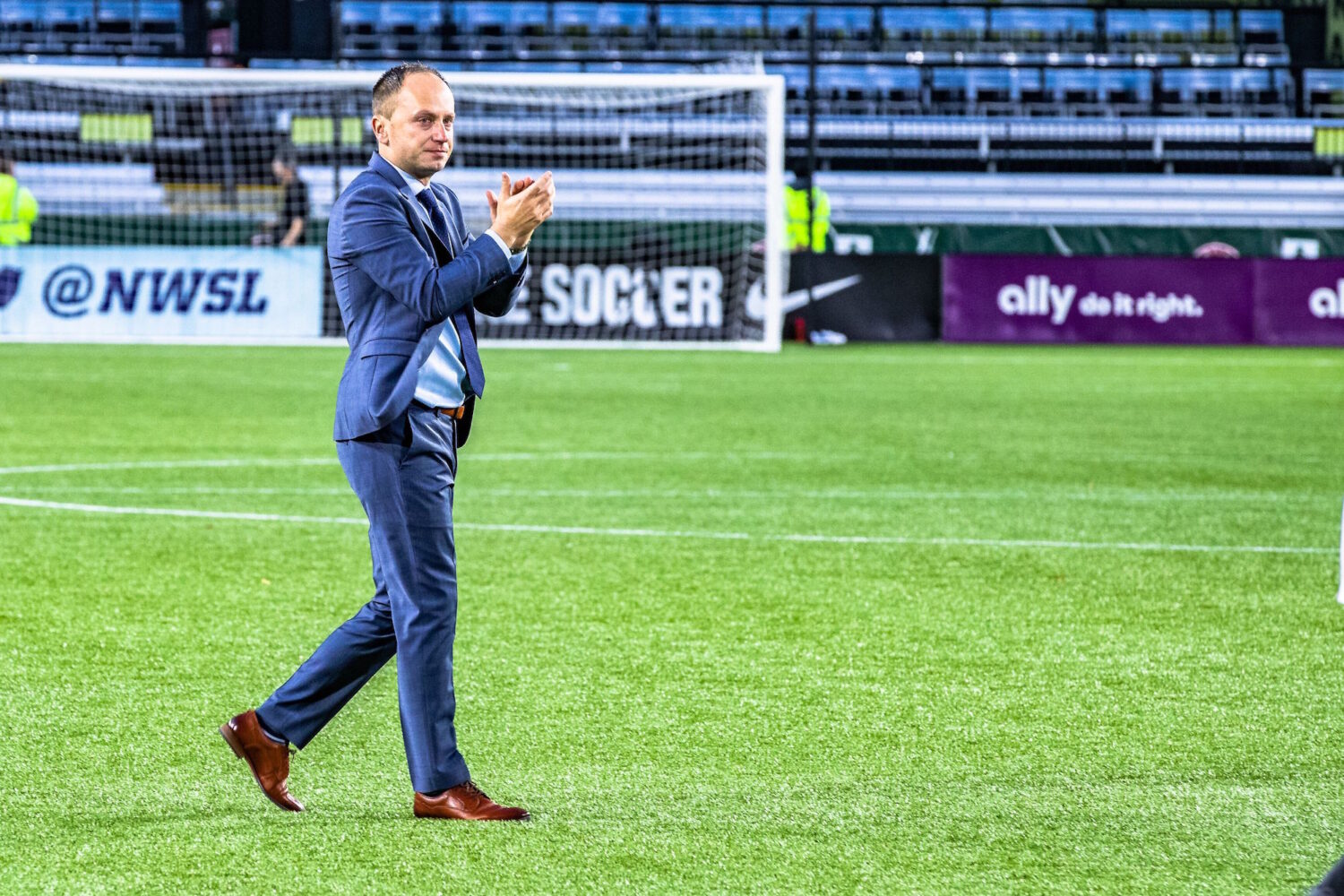
The supply of suffering is infinite. It is the sting of a playoff loss, the sunburn one gets at an afternoon game in August. It is when Tobin Heath’s rights get snapped up in an expansion draft for no good reason.
We cannot stop these things from happening (please do wear sunscreen). Pain will happen. Loss will happen. Suffering is adjacent, but different: its root is in clinging. We cling to players and coaches, clearly. We cling to the idea of winning everything, to the high of a championship, to the moment when a player is one on one with the keeper and is surely, surely going to score. There is nothing here (see above). It’s like trying to scoop up sand with a sieve. Once we understand this, we can begin to get free.
It is only in letting go that we can fully experience anything. If we relinquish expectation, we start to feel that the very fact of the game is a miracle. The weight and texture of the ball, the sun and the rain, the existence of feet. We see that the moment a player is one on one with the keeper is a spark of magic, regardless of what happens next (what happens next doesn’t exist, until it does). The goal itself is an unalloyed joy, if we let it stand by itself.
Even the pain of loss, if we look at it right, is a thing to experience, to open ourselves up to. It doesn’t last. Or you might feel it today, but not tomorrow, and then again the next day. It is not us.
In this way, nothing is ever old. Everything is as new as the moment when we take it in. The world is remade in each moment, and so are we. May we always remember this. May we never feel old.
